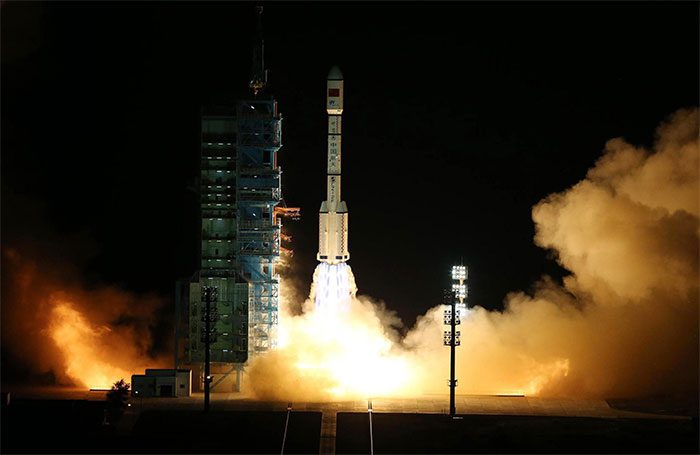Three Chinese astronauts have been launched into space, beginning a six-month mission aboard the country’s new space station. This is China’s latest step in its quest to become a leading space power for decades to come.
Understanding the Tiangong Space Station
Last year, China launched the first module of the Tiangong space station into orbit. They plan to add more modules to support various functional activities on Tiangong. Accordingly, China will launch the Mengtian scientific laboratory module by the end of this year.
Next year, they will send a space telescope, known as Xuntian. This system will orbit near the main space station to facilitate maintenance and refueling when necessary.
Tiangong will have its own systems, propulsion, life support, and living quarters.
China is the third country in history to send astronauts into space and build a space station, following the Soviet Union (now Russia) and the United States.
They have grand ambitions for Tiangong and hope that this station can eventually replace the International Space Station (ISS), which is expected to be decommissioned in 2031.
Chinese astronauts are not allowed on the ISS due to U.S. laws that prohibit NASA from sharing data with China.

The Long March-2F rocket, carrying the Shenzhou 14 spacecraft and three astronauts, launched from the Jiuquan Satellite Launch Center on June 5 to enter orbit. (Photo: Reuters).
China’s Plans for the Moon and Mars
China’s ambitions do not stop there. In a few years, they aim to collect sample materials from near-Earth asteroids.
By 2030, they plan to send their first astronauts to the Moon and dispatch probes to collect samples from Mars and Jupiter.
What Are Other Countries Doing?
As China expands its role in space, several other countries are also aiming for the Moon.
NASA plans to return to the Moon with astronauts from the U.S. and other nations starting in 2025 and is currently finalizing its massive Space Launch System (SLS) at Kennedy Space Center.
Japan, South Korea, Russia, India, and the United Arab Emirates (UAE) are also conducting their own lunar missions.
India has initiated its second major lunar mission and aims to have its own space station by 2030.
Meanwhile, the European Space Agency, currently collaborating with NASA on lunar missions, is planning to establish a network of satellites around the Moon to facilitate communication between astronauts and Earth.
Space Regulations?
The United Nations Outer Space Treaty of 1967 states that no country can claim sovereignty in space.
The UN Moon Agreement of 1979 also indicates that space should not be exploited for commercial purposes; however, the U.S., China, and Russia have refused to sign it.
Currently, the U.S. is promoting the Artemis Accords, outlining how countries can collaboratively exploit lunar resources.
Russia and China have stated they will not sign this agreement, arguing that the U.S. has no right to set rules for space.
China’s Space History
China launched its first satellite into orbit in 1970. Other powers that reached space during that period included the U.S., the Soviet Union, France, and Japan. Over the past decade, China has launched more than 200 rockets. They have also deployed an unmanned spacecraft to the Moon, named Chang’e 5, to collect and return rock samples. They planted a larger Chinese flag on the Moon’s surface than previous American flags.
With the launch of the Shenzhou 14, China has sent 14 astronauts into space, compared to 340 from the U.S. and over 130 from the Soviet Union (now Russia).
However, the country has also faced setbacks. In 2021, a part of a Chinese rocket fell out of orbit and crashed into the Atlantic Ocean, and they experienced two failed launches in 2020.
Funding for China’s Space Program
Chinese state media Xinhua reported that at least 300,000 people have worked on China’s space projects—nearly 18 times the number currently employed by NASA.
The China National Space Administration was established in 2003 with an initial annual budget of two billion yuan (approximately 300 million USD).
However, in 2016, China opened its space industry to private companies, which now invest over 10 billion yuan (about 1.5 billion USD) annually, according to Chinese media.
Why Is China Going into Space?
China is eager to develop its satellite technology to advance telecommunications, air traffic management, weather forecasting, navigation, and more.
However, according to the BBC, many of their satellites also serve military purposes. They can assist in spying on rival powers and guiding long-range missiles.
Lucinda King, a space project director at the University of Portsmouth, stated that China is not only focused on large-scale space missions: “They are strong in every aspect of space. They have the political motivation and resources to fund planned programs.”
China’s lunar missions are partly driven by the opportunity to extract rare earth metals from the lunar surface, such as lithium.
However, Professor Sa’id Mosteshar, Director of the Space Law and Policy Institute at University College London, mentioned that the country may not be willing to pay just to send extraction vessels to the Moon repeatedly. Instead, China’s space program is largely motivated by the desire to impress the rest of the world. “The space program is an indicator of power and a testament to technological progress.”


















































